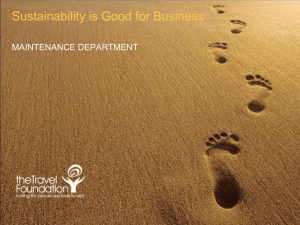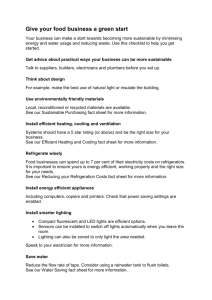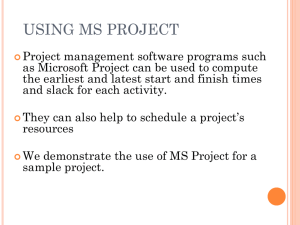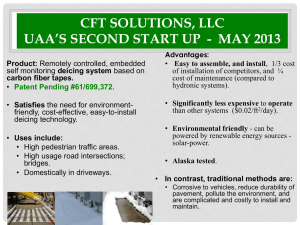CS 230 Software Design (Engineering)
advertisement
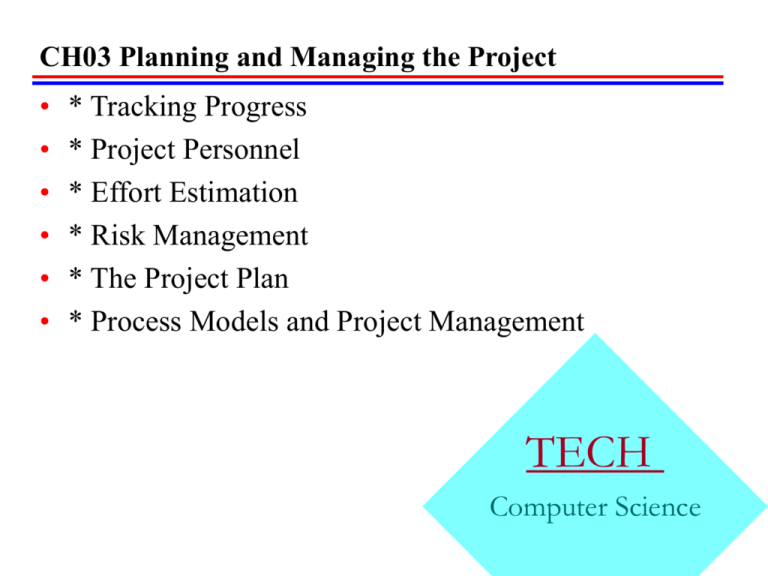
CH03 Planning and Managing the Project • • • • • • * Tracking Progress * Project Personnel * Effort Estimation * Risk Management * The Project Plan * Process Models and Project Management TECH Computer Science Tracking Progress • Questions from our customers Do you understand my problem and my needs? Can you design a system that will solve my problem or satisfy my needs? How long will it take you to develop such a system? How much will it cost to have you develop such a system? • Require a well-thought-out project schedule Project Schedule PHASE 1 STEP 1 STEP 2 : PHASE 2 STEP 1 STEP 2 : PHASE n STEP 1 STEP 2 : PROJECT ACTIVITY 1.1 ACTIVITY 1.2 ACTIVITY 1.3 : ACTIVITY 2.1 ACTIVITY 2.2 ACTIVITY 3.3 : Activity and Milestone • Activity is a part of the project that takes place over a period of time. • Milestone is the completion of an activity -- a particular point in time. • Describe each activity precursor duration due date endpoint START Request permits 1.2 Surveying 1.1 Excavation Activity Graph 1.3 Buy materials 1.4 Lay foundation 2.1 2.3 Install exterior electrical 2.4 Install exterior siding 2.5 Paint exterior 2.6 Install exterior doors and 2.7 fixtures Install exterior Build outside wall plumbing 2.2 3.1 Install interior Install interior elec plumbing 3.2 Install wallboard 3.3 Paint interior Install flooring 3.5 Install roofing 3.4 Install 2.8 interior door 3.6 and fixtures FINISH START 15 1.2 3 1.1 10 1.3 10 Activity Graph 1.4 with Duration 15 2.1 10 2.2 2.3 20 3.1 15 3.2 9 3.3 11 12 10 2.4 8 5 2.5 2.6 6 18 9 2.8 2.7 0 3.5 3.4 0 0 7 3.6 FINISH 0 Estimating Completion • Critical Path Method (CPM) analyzes the paths among the milestones. Shows the minimum amount of time it will take to complete the project. Reveals those activities that are most critical to completing the project on time. • Trace through each path from start to finish, adding up the time. • Critical path is the longest path. Real time, Available time, Slack time • Real time for an activity is the estimated amount of time required for the activity to be completed. • Available time is the amount of time available in the schedule for the activity’s completion. • Slack time = available time - real time • Slack time = latest start time - earliest start time • e.g. surveying Tools to Track Progress: Gantt chart TODAY ACTIVITY NUMBER DESCRIPTION JAN FEB MAR APR MAY JUN JUL AUG SEP OCT NOV DEC WBS 1.0 SYSTEM PLANNING Specification approved 1.1 Review specification 1.2 Review budget Budget approved Schedule approved 1.3 Review schedule 1.4 Develop plan Plan approved WBS 2.0 SYSTEM DESIGN Design approved 2.1 Top-level design 2.2 Prototyping 2.3 User interface Design approved 2.4 Detailed design Completed Duration Float Critical Slippage Start task Finish task Project Personnel • To determine the project schedule and estimate the associated effort and costs, we need to know: home many people will be working on the project, what tasks they will perform, and what abilities and experience they must have. • Who does what, and how the staff can be organized. Staff Roles and Characteristics • ability to perform the work • interest in the work • experience with similar applications, tools, languages, techniques, and development environment • training • ability to communicate and to share responsibility with others • management skills INTUITIVE INTROVERT: Asks others Acknowledges feelings INTUITIVE EXTROVERT: Tells others Acknowledges feelings RATIONAL INTROVERT: Asks others Decides logically RATIONAL EXTROVERT: Tells others Decides logically RATIONAL EXTROVERT INTROVERT Work Styles INTUITIVE Communications Two people 1 line of communication Three people 3 lines of communication Four people 6 lines of communication Five people : n people 10 lines of communicatio : n(n-1)/2 lines of communication Meetings (complaints) // • • • • • The purpose of the meeting is unclear. The attendees are unprepared. Essential people are absent or late. The conversation veers away from its purpose. Participants argue, dominate the conversation, or do not participate. • Decisions made at the meeting are never enacted afterward. Project Team Organization • Team members are organized in ways that enhance the swift completion of quality products. • Choice of an appropriate structure depends: the backgrounds and work styles of the team members the number of people on the team the management styles of the customers and developers Chief Programmer team Chief programmer Assistant chief programmer Senior programmers Junior programmers Librarian Administration Test team Egoless Approach • holds everyone equally responsible. • Criticism is made of the product or the result, not the people • all team members vote on a decision. Comparison of Organizational Structures • Highly Structured High certainty Repetition Large projects • Loosely Structured Uncertainty New Techniques or technology Small projects Creative Effort Estimation: How much the project COST • Several types of costs: facilities, staff, and methods and tools. • Facilities: 100 square feet of dedicated floor space, 30 square feet of table space, floor-to-ceiling enclosure, free from phone calls and uninvited visitors --- for each person to work effectively. • Staff: the biggest component of cost is effort, how many staff-days • Tools: tools and training cost. Estimation techniques: • • • • Expert Judgement Algorithmic Methods Machine-learning Methods Finding the Model for Your Situation Expert Judgement • Ask an Expert • Analogies and educated guess • Asking three predictions: pessimistic one (x) optimistic one (y) Most likely guess (z) • Normalized by (x + 4y + z)/6 Expert Judgement: Delphi technique • • • • Ask each individual predictions secretly Calculate average estimate Present the estimate to the group Allow them to revise Algorithmic Methods • Express the relationship between the effort and the factors that influence it. • E = 5.25 S 0.91 S is size in lines of code • E = 5.5 + 0.73 S 1.16 (by Bailey) • Size Estimation problem Estimates required before size information is available. COCOMO 2.0 • • • • • • Estimates size in terms of high-level objects, such as, number of server data tables, number of client data tables, number of screens, number of reports percentage of screens and reports reused from previous projects Productivity Factors • • • • • Customer interface complexity User participation in requirements definition Customer-originated program design changes Customer experience with the application area Overall personnel experience Productivity Factors (continue) • • • • • • Use of Structured Programming Use of design and code inspections Use of top-down development Overall complexity of code Complexity of program flow Overall constraints on program’s design Machine-learning Methods • Learn from the past projects • predict the future cost • Neural Network approach training the network with data from past projects network values are adjusted to reflect past experience training methods, such as back-propagation use the network to produce an effort estimate Neural Network e.g. Problem complexity Novelty of application Use of design tools Effort Team size Input layer Intermediate layersOutput layer Case-based Reasoning (CBR) • build case history of past projects • Using CBR system User identifies a new problem as a case it retrieves similar cases from a repository of historical information it reuses knowledge from previous cases it suggests a solution for the new case • How to characterizing cases and determining similarity Finding the Model for Your Situation • Which model is the best? • Depending on your situation • In general based on comparison data, Bailey-Basili model performs batter than others. Different reports of effort distribution // Planning Testing Planning Coding Coding Other Brooks Yourdon Risk Management • A risk is an unwanted event that has negative consequences. • Risk management involves understanding and controlling the risks. • Generic Risk: common to all software projects • Project specific Risk: particular vulnerabilities of the given project. Defining and Quantifying the Risk • Risk impart: the loss associated with a risk • Risk probability: the likelihood for the risk to occur • Risk exposure = risk impart * risk probability Risk Reduction • Risk control: a set of actions taken to reduce or eliminate a risk • Justify the action: • Risk leverage = (Risk exposure before reduction - risk exposure after reduction) / (cost of risk reduction) • Record your decisions in a risk management plan. Risk Management Activities Checklist Decomposition Risk identification Assumption analysis Decision driver analysis Risk assessment System dynamics Risk analysis Performance models Risk prioritization Cost models Network analysis Decision analysis Quality risk factor analy k management Risk exposure Compound risk reduction Buying information Risk avoidance Risk transfer Risk reduction leverage Risk reduction Development process Risk control Risk management planning Risk element planning Risk plan integration Risk mitigation Risk resolution Risk monitoring and reporti Risk reassessment “Top Ten List” of Risk Items • • • • • 1. Personnel shortfalls 2. Unrealistic schedules and budgets 3. Developing the wrong software functions 4. Developing the wrong user interface 5. Gold plating (cost overrun) “Top Ten List” of Risk Items (more) • 6. Continuing stream of requirements changes • 7. Shortfalls in externally (other groups or co.) performed tasks • 8. Shortfalls in externally furnished components • 9. Real-time performance shortfalls • 10. Straining computer science capabilities The Project Plan • We write a document called a project plan to communicate risk analysis and management, project cost estimates, schedule, and organization • to our customers and our own group Items for good project plan • • • • • project scope project schedule project team organization technical description of the proposed system project standards, procedures, and proposed techniques and tools • quality assurance plan More Items for good project plan configuration management plan documentation plan data management plan resource management plan test plan training plan security plan risk management plan maintenance plan Process Models and Project Management • managing at building quality products on time and within budget • tailor the project management techniques to particular characteristics of the resources needed, the chosen process, and the people assigned. Enrollment Management • Case study: Digital Alpha AXP project • Vision enrollment (Business Goals, Project objectives): establish and shared common goals • Commitment delegation (Trust, Accountability) result was measurable and identified with a particular owner who is held accountable for delivery. Enrollment Management (more) • Inspection and support (Review, Encouragement) inspect to make sure that delivery would be on time, identify risk supportive feedback and make changes to help move the project forward • Acknowledgement and learning (Personal, Public) acknowledgement progress both personally and publicly recorded what had been learned and how things could be improved One-page Master plan • see the “big picture” • have a global picture of what to do, and when and how to do it • regular operation inspections One-page report: itemizing key points • • • • • • schedule milestones critical-path events in the past month activities along the critical path in the next month issues and dependencies resolved issues and dependencies not resolved (with ownership and due dates) Recognition of job well done • engineers are usually motivated more by recognition than by financial gain • announcing progress in public and managers show appreciation Flexible and focused management • resulting in meeting schedule, • producing exceptional product, • meeting performance goals. Accountability Modeling • U.S. Air Force and Lockheed Martin (F-16 software case study) • More than four Million lines of code, a quarter of which met real-time deadlines in flight. • Integrated product development team: combining individuals from different functional groups into an interdisciplinary work unit, empowered with separate channels of accountability Team and Stakeholder • Team: any collection of people responsible for producing a given (desired) result • Stakeholder: anyone affected by that result or the way in which the result is achieved. • Accounting: a report of what you have done, are doing, or plan to do • Consequences: with the goal of doing only what makes sense for both the team and the stakeholders Accountable • including a weekly team status review • each personal action item had explicit closure criteria and was tracked to completion • activity map showing progress on each activity in the overall context of the project • earned value: a scheme for comparing activities and their contribution to the overall progress of the project Accounting hand-off from one team to others • coordination among different teams: use software to track the hand-off from one team to another • Accountability model coupled with hand-off model provide mechanism for communication and coordination encourage risk management integrated progress reporting with problem solving Accountability model applied • to the design of management systems, • to team operation procedures, • replacing independent behaviors with interdependence, • emphasizing: “being good rather than looking good” !!! Anchoring Milestones • Win-Win Spiral Model (US. Department of Defense’s STARTS program case study) reduces from $140 to $57 per delivered line of code, quality improved from 3 to 0.035 fault per thousand delivered lines of code.

